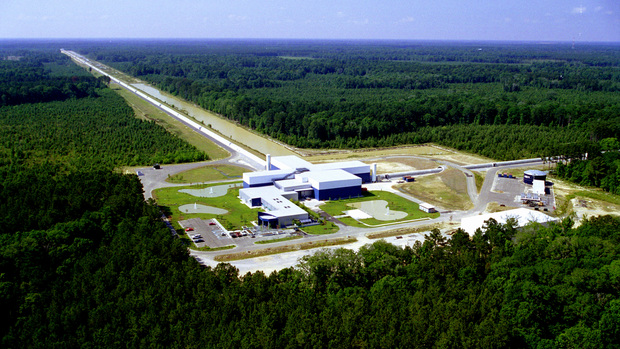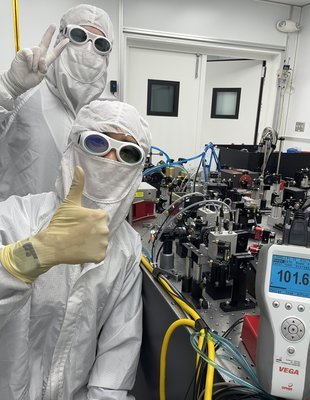
LIGO Ready to Explore Secrets of the Universe
News Release • May 24, 2023
Global network of gravitational-wave detectors starts next observing run
Today, the LIGO-Virgo-KAGRA (LVK) collaboration begins a new observing run with upgraded instruments and other improvements to boost the search for gravitational waves, or ripples in space-time, generated by colliding black holes and other extreme cosmic events. The LVK collaboration consists of scientists across the globe who use a network of gravitational-wave observatories—LIGO in the United States, Virgo in Europe, and KAGRA in Japan.
This observing run, the fourth since the National Science Foundation-funded LIGO made history in 2015 by making the first direct detection of gravitational waves, will be the most sensitive yet. Called 04, the run begins on May 24, 2023, and will last 20 months, including up to two months of commissioning breaks, during which work will be undertaken to further improve instrument performance. The observing run will begin with the twin LIGO observatories resuming operations May 24; Virgo will join later in the year. KAGRA will join for one month beginning on May 24, then rejoin later in the run after some upgrades.

Masayuki Nakano and Torrey Cullen celebrate an engineering milestone at LIGO Livingston. Image credit: LIGO/Caltech/MIT
"Our LIGO teams have worked through hardship during the past two-plus years to be ready for this moment, and we are indeed ready: our engineering run leading up to tomorrow's official start of 04 has already revealed a number of candidate events, which we have shared with the astronomical community," says Caltech's Albert Lazzarini, the deputy director of the LIGO Laboratory. "Most of these involve black hole binary systems, although one may include a neutron star. The rates appear to be consistent with expectations."
The LIGO detectors will begin the run with an increase in sensitivity of approximately 30 percent. This increased sensitivity means that the detectors will observe a larger fraction of the universe than before and will pick up gravitational-wave signals at a higher rate, detecting a merger every two or three days.
Additionally, the increased sensitivity will allow scientists to extract more physical information from the data, which will allow them to better test Albert Einstein's general theory of relativity and infer the true population of dead stars in the local universe.
"Thanks to the work of more than a thousand people around the world over the last few years, we'll get our deepest glimpse of the gravitational-wave universe yet," said Jess McIver, the deputy spokesperson for the LIGO Scientific Collaboration (LSC). "A greater reach means we will learn more about black holes and neutron stars, and increases the chances we will find something new. We're very excited to see what's out there."
The first gravitational-wave signals were detected in 2015. Two years later, LIGO and Virgo detected a merger of two neutron stars, which caused an explosion called a kilonova, subsequently observed by dozens of telescopes around the world. So far, the global network has detected more than 80 black hole mergers, two probable neutron star mergers, and a few events that were most likely black holes merging with neutron stars.
As in previous observing runs, alerts about gravitational-wave detection candidates will be distributed publicly. Information about how to receive and interpret public alerts is available at wiki.gw-astronomy.org/OpenLVEM.
The Virgo detector will continue commissioning activities to increase its sensitivity before joining the run later this year. "Over the past few months, we have identified various noise sources and have made good progress in sensitivity, but it is not yet at its design goal," declared recently elected Virgo spokesperson Gianluca Gemme. "We are convinced that achieving the best detector sensitivity is the best way to maximize its discovery potential."
KAGRA is now running with the sensitivity that was planned for the beginning of the run. Jun'ichi Yokoyama, the chair of KAGRA Scientific Congress, says, "We will join O4 for one month and resume commissioning to further improve the sensitivity toward our first detection."
More information about the observatories
LIGO is funded by the National Science Foundation (NSF), and operated by Caltech and MIT, which conceived and built the project. Financial support for the Advanced LIGO project was led by NSF with Germany (Max Planck Society), the U.K. (Science and Technology Facilities Council), and Australia (Australian Research Council) making significant commitments and contributions to the project. More than 1,500 scientists from around the world participate in the effort through the LIGO Scientific Collaboration, which includes the GEO Collaboration. Additional partners are listed at ligo.org/partners.php.
The Virgo Collaboration is currently composed of approximately 850 members from 143 institutions in 15 different (mainly European) countries. The European Gravitational Observatory (EGO) hosts the Virgo detector near Pisa in Italy and is funded by Centre national de la recherche scientifique (CNRS) in France, the Istituto Nazionale di Fisica Nucleare (INFN) in Italy, and the National Institute for Subatomic Physics (Nikhef) in the Netherlands. A list of the Virgo Collaboration groups can be found at public.virgo-gw.eu/the-virgo-collaboration/.
KAGRA is a laser interferometer in Kamioka, Gifu, Japan. The host institute is the Institute for Cosmic Ray Research (ICRR) at the University of Tokyo, and the project is co-hosted by the National Astronomical Observatory of Japan (NAOJ) and the High Energy Accelerator Research Organization (KEK). The KAGRA collaboration is composed of more than 480 members from 115 institutes in 17 countries/regions.




